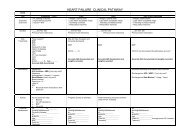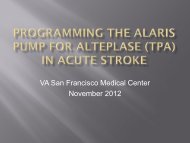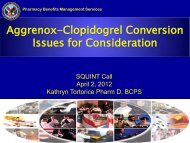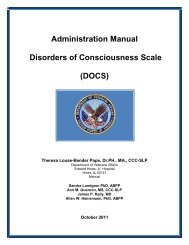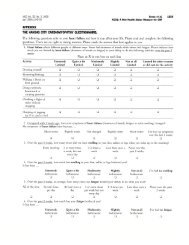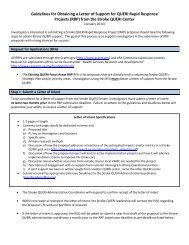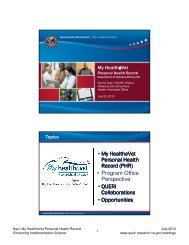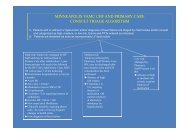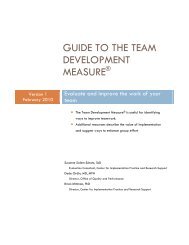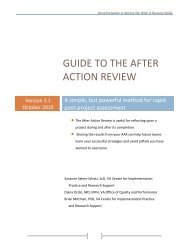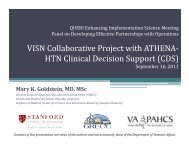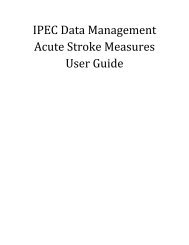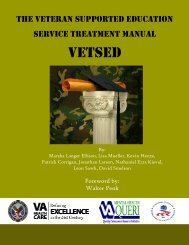National Institute of Health Stroke Scale (NIHSS) - QUERI
National Institute of Health Stroke Scale (NIHSS) - QUERI
National Institute of Health Stroke Scale (NIHSS) - QUERI
You also want an ePaper? Increase the reach of your titles
YUMPU automatically turns print PDFs into web optimized ePapers that Google loves.
Pitch Mandava, MD, PhD<br />
Director, <strong>Stroke</strong> Center<br />
Michael E. DeBakey VAMC<br />
Jane Anderson, PhD, RN, FNP<br />
Associate Director, <strong>Stroke</strong> Center<br />
Michael E. DeBakey VAMC
Describe the purpose <strong>of</strong> the <strong>NIHSS</strong><br />
Discuss guiding principles to consider when<br />
administering the <strong>NIHSS</strong><br />
Demonstrate and discuss the individual<br />
components <strong>of</strong> the exam<br />
Describe how to accurately interpret the<br />
<strong>NIHSS</strong> score
Multiple measures, or scales, have been develop<br />
to quantify neurological impairment.<br />
All involve scoring various modalities <strong>of</strong><br />
neurological function and then summing the<br />
scores to provide an index <strong>of</strong> neurological status.
• First stroke scale introduced - Mathew et al, 1972<br />
1980s & 1990s - Steadily increase in the number <strong>of</strong><br />
scales to quantify neurological impairment.<br />
<br />
<br />
<br />
<br />
<br />
Middle Cerebral Artery Neurological Score<br />
• Orgogozo et al, 1983<br />
Scandinavian <strong>Stroke</strong> <strong>Scale</strong><br />
• Scandinavian <strong>Stroke</strong> Study Group, 1985<br />
Canadian Neurological <strong>Scale</strong><br />
• Cote et al, 1986<br />
<strong>National</strong> <strong>Institute</strong>s <strong>of</strong> <strong>Health</strong> <strong>Stroke</strong> <strong>Scale</strong><br />
• Brott et al, 1989<br />
European <strong>Stroke</strong> <strong>Scale</strong><br />
• Hantson et al, 1994
<strong>NIHSS</strong> was developed for adjusting final<br />
outcome for initial severity <strong>of</strong> stroke in clinical<br />
trials.<br />
<strong>NIHSS</strong> has been used to predict outcome despite<br />
not having been designed for this purpose.<br />
• Acute scores on the <strong>NIHSS</strong> correlate with both CT<br />
infarct volume at 7 to 10 days after stroke and<br />
functional outcome at 3 months.<br />
<strong>NIHSS</strong> scales should not be used as a measure <strong>of</strong><br />
functional outcome itself, since impairment<br />
only partly explain functional health.
Standardized stroke severity scale to<br />
describe neurological deficits in acute stroke<br />
patients<br />
Allows us to:<br />
• Quantify our clinical exam<br />
• Determine if the patients’ neurological status is<br />
improving or deteriorating<br />
• Provide for standardization<br />
• Communicate patient status
11 item scoring system<br />
Integrates components <strong>of</strong> neurological exam<br />
Includes testing <strong>of</strong> LOC, select cranial<br />
nerves, motor, sensory, cerebellar function,<br />
language, inattention (neglect)<br />
Maximum score: 42, minimum score: 0<br />
Not a linear scale
Neurological Examination<br />
LOC<br />
Mental status and<br />
cognitive function<br />
Cranial nerves<br />
Motor system<br />
Sensory function<br />
Cerebellar system<br />
(coordination and gait)<br />
Reflexes<br />
<strong>NIHSS</strong><br />
LOC<br />
Best gaze<br />
Visual field testing<br />
Facial paresis<br />
Arm & leg motor function<br />
Limb ataxia<br />
Sensory<br />
Best language<br />
Dysarthria<br />
Extinction & inattention
The most reproducible response is generally<br />
the first response<br />
Do not coach patients unless specified in the<br />
instructions<br />
Some items are scored only if definitely<br />
present<br />
Record what the patient does, not what you<br />
think the patient can do
Performing Instructions<br />
1a. Level <strong>of</strong> Consciousness<br />
The investigator must choose a<br />
response.<br />
A 3 is scored only if the patient<br />
makes no movement (other than<br />
reflexive posturing) in response to<br />
noxious stimulation.<br />
Scoring Instructions<br />
0 = Alert; keenly responsive<br />
1 = Not alert, but arousable by minor<br />
stimulation to obey, answer or<br />
respond<br />
2 = Not alert, requires repeated<br />
stimulation to attend, or is obtunded<br />
and requires strong or painful<br />
stimulation to make movements<br />
3 = Responds only with reflex motor<br />
or autonomic effects or totally<br />
unresponsive, flaccid
Determined through interactions with the<br />
patient<br />
Auditory stimulation (normal →loud voice)<br />
Tactile stimulation (light → painful)
0 = Alert, keenly, responsive<br />
1 = Not alert, but arousable by minor stimulation<br />
2 = Not alert, requires repeated stimulation to<br />
attend, or painful stimulation to make<br />
movements<br />
3 = Responds only with reflex motor or<br />
autonomic effects or totally unresponsive
Ask the patient their age … wait for a<br />
response…<br />
Ask the patient the current month …wait for<br />
a response…<br />
Note:<br />
• Do not give credit for being “close”<br />
• Do not coach or give non verbal cues
0 = Answers both questions correctly<br />
1 = Answers one question correctly<br />
2 = Answers neither question correctly<br />
Note:<br />
• Aphasic patients who do not comprehend the questions<br />
will score 2<br />
• Patients unable to speak due to endotracheal intubation,<br />
orotracheal trauma, severe dysarthria from any cause,<br />
language barrier or any other problem not secondary to<br />
aphasia are given a 1
Ask patient: open and close your eyes and<br />
grip and release the nonparetic hand.<br />
• Give credit if an unequivocal attempt is made<br />
but not completed due to weakness<br />
• If patient does not respond to command, the<br />
task should be demonstrated
0 = Performs both tasks correctly<br />
1 = Performs one task correctly<br />
2 = Performs neither task correctly<br />
Note:<br />
• Score only the first attempt
Ask the patient to "follow my finger" across<br />
horizontal eye movements<br />
• Aphasic or confused patients: use tracking<br />
• Unconscious patients: use oculocephalic<br />
maneuver<br />
• OK to coach
Tracking: establishing eye contact and moving<br />
about the patient from side to side and<br />
observing if the patient’s eyes follow<br />
The oculocephalic reflex (doll’s eyes) assessed<br />
by briskly rotating the patient’s head side to<br />
side.<br />
Note:<br />
• Normal response: eyes move in the opposite direction to<br />
head movement<br />
• Abnormal response: the eyes are fixed in one position<br />
and follow the direction <strong>of</strong> passive rotation
0 = Normal horizontal eye movements<br />
1 = Partial gaze palsy – abnormality in one or<br />
both eyes, but forced deviation is not<br />
present<br />
2 = Forced deviation, or total gaze paresis<br />
(not overcome with oculocephalic maneuver)
Stand 2 feet from patient at eye level. Both<br />
examiner and patient cover one eye. Ask patient<br />
to look directly into your eyes.<br />
Test upper and lower visual fields by<br />
confrontation (4 quadrants <strong>of</strong> each eye).<br />
Examiner compares this to the “norm” (their<br />
own vision)<br />
To test both fields with eyes open, ask pt to<br />
indicate where they see movement (choices: L<br />
side, R side or both)
0 = No visual loss<br />
1 = Partial hemianopia (sector or<br />
quadrantanopia)<br />
2 = Complete hemianopia<br />
3 = Bilateral hemianopia (blind)<br />
Note:<br />
• If patient sees moving fingers, this can be scored as<br />
normal<br />
• If there is unilateral blindness or enucleation, score<br />
visual fields in the other eye<br />
• If there is extinction during double simultaneous<br />
stimulation score a 1 and use the results to answer<br />
question 11
Ask the patient or use pantomime<br />
• “Show me your teeth, raise your eyebrows and<br />
close your eyes tightly”<br />
Score symmetry <strong>of</strong> grimace to noxious<br />
stimulation in the aphasic or confused<br />
patient (tickle each nasal passage one at a<br />
time using a cotton-tipped applicator and<br />
observe facial movement)
0 = Normal symmetrical movement<br />
1 = Minor paralysis: (i.e., flattened nasolabial<br />
fold, asymmetry on smiling)<br />
2 = Partial paralysis (total or near total paralysis<br />
<strong>of</strong> lower face)<br />
3 = Complete paralysis <strong>of</strong> one or both sides<br />
(absence <strong>of</strong> facial movement in the upper and<br />
lower face)<br />
Note:<br />
• Aphasic or confused patient: Score symmetry <strong>of</strong> grimace<br />
to noxious stimulation
Test each limb independently<br />
Start with non-paretic arm<br />
Place the limb in the appropriate position<br />
• Extend arm (palm down) 90°sitting/45°supine<br />
• Leg 30 degrees (supine)<br />
Drift = arm falls before 10 sec. or leg before 5 sec.<br />
DIP vs DRIFT<br />
• Dip: very small change with instantaneous correction<br />
• Drift: limb lowers to any significant degree. Drift is never<br />
normal.<br />
COUNT OUT LOUD & using your fingers in patient’s view<br />
• Aphasic patient: Use urgency in voice and pantomime to<br />
encourage
0 = No Drift – limb holds steady for full count<br />
• 10 sec-arm, 5 sec-leg<br />
1 = Drift BUT limb does not hit bed or other<br />
support<br />
2 = Drifts towards bed, BUT pt has some effort<br />
against gravity<br />
3 = Limb falls, NO effort against gravity. Trace<br />
muscular contraction present in limb<br />
4 = No movement<br />
X = Amputation, joint fusion
Finger-Nose-Finger: The examiner raises their<br />
finger midline, 2 ft from the patient<br />
• Patient is asked, “With your right hand, touch my finger,<br />
then touch your nose; do this as fast as you can.”<br />
Repeat with the other arm.<br />
Heel to Shin: Pt can be lying on their back or<br />
sitting<br />
• Ask pt to slide one heel down shin <strong>of</strong> the opposite leg,<br />
then repeat the same procedure on the other side<br />
Dysmetria: the inability to accurately control the<br />
range <strong>of</strong> movement in muscle action with the<br />
resultant overshooting <strong>of</strong> the mark
Detects unilateral cerebellar lesion & limb<br />
movement abnormalities in relation to sensory or<br />
motor dysfunction<br />
Use “finger-nose-finger” and “heel to shin” tests<br />
Test non-paretic side first<br />
Look for smooth, accurate movements<br />
Consider limb weakness when looking for<br />
dysmetria<br />
Non verbal cues are permitted<br />
Test all four limbs separately
0 = Absent<br />
1 = Present in one limb<br />
2 = Present in two limbs<br />
Note:<br />
• Ataxia is only scored if present. In patient who can’t<br />
understand the exam or who is paralyzed, a score <strong>of</strong><br />
0 (absent) is given<br />
• If patient has mild ataxia and you cannot be certain<br />
that it is out <strong>of</strong> proportion to demonstrated<br />
weakness, give a score <strong>of</strong> 0
Use sharp object on face, arms (not hands), trunk<br />
and legs<br />
Compare pinprick in same location on both sides.<br />
Ask patient if they can feel the pinprick, if it is<br />
different from side to side, and how it is different<br />
Record grimace or withdrawal from noxious<br />
stimulus in obtunded or aphasic patients<br />
Only record sensory loss due to stroke<br />
Only record sensory loss if it is clearly<br />
demonstrated
0 = Normal, no sensory loss<br />
1 = Mild to moderate sensory loss; patient is<br />
aware <strong>of</strong> being touched but pinprick is less<br />
sharp/dull on the affected side<br />
2 = Severe to total sensory loss; patient is not<br />
aware <strong>of</strong> being touched in the face, arm and leg<br />
Note:<br />
• A score <strong>of</strong> 2 should only be given when severe or total<br />
loss <strong>of</strong> sensation can be clearly demonstrated<br />
• Stuporous and aphasic patients will probably score 1 or 0
Incorporates information collected in preceding<br />
sections<br />
Ask patient to perform the following:<br />
• Name all the objects on the card<br />
• Read all the sentences<br />
• Describe what is happening in the picture<br />
Give patient adequate time<br />
Patient can write answers<br />
If visual loss prevents standard examination:<br />
• Place objects in patient’s hand (naming),<br />
• Ask patient to repeat sentences on the card<br />
• Ask patient to produce speech by asking a question
0 = No aphasia, normal fluency and comprehension<br />
1 = Mild to mod aphasia: some obvious loss <strong>of</strong> fluency or<br />
comprehension, but able to “get their ideas across”<br />
2 = Severe aphasia: all communication limited, examiner<br />
must guess what the pt is trying to communicate<br />
3 = Mute, global aphasia: no useable speech, no auditory<br />
comprehension. Pt unable to follow any one step<br />
commands.<br />
Note:<br />
• To choose between a score <strong>of</strong> 1 or 2, use all provided<br />
materials. It is anticipated that a patient who missed more<br />
than two thirds <strong>of</strong> the naming objects and sentences or who<br />
followed only few and simple one step commands would score<br />
a 2.
An adequate sample <strong>of</strong> speech must be<br />
obtained by asking patient to read or repeat<br />
words from the attached list even if patient<br />
is thought to be normal<br />
If the patient has aphasia, the clarity <strong>of</strong><br />
articulation <strong>of</strong> spontaneous speech can be<br />
rated
0 = Normal<br />
1 = Mild to moderate; patient slurs some words<br />
but can be understood<br />
2 = Severe; patient’s speech is so<br />
slurred/unintelligible in the absence <strong>of</strong> or out <strong>of</strong><br />
proportion to any dysphasia, or is mute<br />
X = Intubated or other physical barrier
Sufficient information to identify neglect may be<br />
obtained during prior testing.<br />
If the patient has a severe visual loss preventing<br />
visual double simultaneous stimulation, and the<br />
cutaneous stimuli are normal, the score is<br />
normal.<br />
If the patient has aphasia but does appear to<br />
attend to both sides, the score is normal.<br />
The presence <strong>of</strong> visual spatial neglect or<br />
anosognosia may also be taken as evidence <strong>of</strong><br />
abnormality.<br />
Since the abnormality is scored only if present,<br />
the item is never untestable.
0 = No abnormality<br />
1 = Visual, tactile, auditory, spatial, or personal<br />
inattention or extinction to bilateral<br />
simultaneous stimulation in one <strong>of</strong> the sensory<br />
modalities.<br />
2 = Pr<strong>of</strong>ound hemi-inattention or hemiinattention<br />
to more than one modality. Does not<br />
recognize own hand or orients to only one side <strong>of</strong><br />
space.
If patient is not co-operative explanation<br />
must be clearly written on the form.<br />
<strong>NIHSS</strong> items are rarely untestable.
Total scores range from 0-42 with higher values<br />
representing more severe infarcts – Max Possible Score<br />
<strong>of</strong> 38. Can not score complete weakness and ataxia.<br />
Can not be mute and dysarthric<br />
• >25<br />
• 15-24<br />
• 5-14<br />
•
Initial score <strong>of</strong> 7 was found to be important cut-<strong>of</strong>f point<br />
• <strong>NIHSS</strong> >7 demonstrated a worsening rate <strong>of</strong> 65.9%.<br />
• <strong>NIHSS</strong> 20 = 17% likelihood<br />
• <strong>NIHSS</strong> < 20 = 3% likelihood<br />
(Adams et al., 2003)
Total <strong>NIHSS</strong> score is an important piece <strong>of</strong><br />
information to relate patient status along with a<br />
full patient assessment.<br />
Communicate the following<br />
• Which neurological area has changed<br />
• How it has changed<br />
• Other new findings (vital signs, pupils, cranial nerve<br />
deficits, mental status etc)<br />
Document your assessment, intervention plans and<br />
follow-up.
Neurological decline<br />
New focal deficit<br />
Advancing neurological deficit<br />
Other concern
VHA Acute Ischemic <strong>Stroke</strong> Directive<br />
mandates that each stroke care facility<br />
develops methods to document and report<br />
the percentage <strong>of</strong> patients with symptoms<br />
<strong>of</strong> AIS that have the NIH <strong>Stroke</strong> <strong>Scale</strong><br />
completed:<br />
• a. Within 45 minutes <strong>of</strong> arrival for patients<br />
within the 120 minute window for r-tPA<br />
administration, or<br />
• b. Within 24 hours <strong>of</strong> admission for patients<br />
presenting outside <strong>of</strong> the window for r-tPA<br />
administration.
NINDS<br />
http://www.ninds.nih.gov/doctors/stroke_scale_training.htm<br />
AHA/ASA<br />
http://learn.heart.org/ihtml/application/student/interface.heart2<br />
/nihsscomputer.html<br />
NSA<br />
http://nihssenglish.trainingcampus.net/uas/modules/trees/windex.aspx



